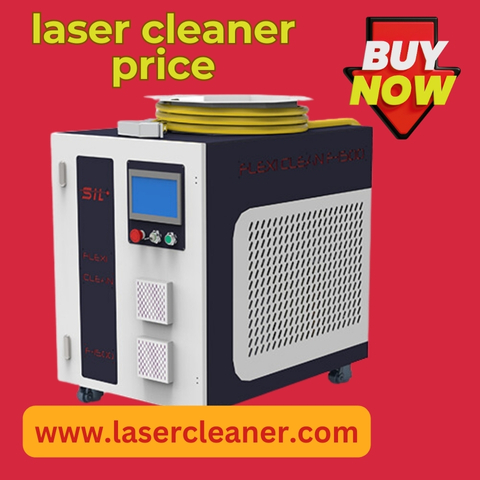
The laser cleaner price has become a widely searched topic in industrial and commercial sectors, especially as more businesses move away from chemical and abrasive methods. But there’s a confusing reality — machines that look alike, claim to offer similar results, and even have the same power ratings can carry dramatically different price tags. Why is that? If you’ve ever wondered what really goes into determining the price of a laser cleaner, you’re not alone. In this guide, we will explain.
The First Misconception About Laser Cleaner Price
At first glance, many assume that laser cleaner price is primarily based on power. A 1000W machine should logically be cheaper than a 2000W one — and that’s partly true. But power rating alone doesn’t define the real cost. Two machines with the same wattage may have a difference of several thousand dollars. That’s because power is only one layer in a much more complex pricing structure.
The Role of Laser Source in Pricing
One of the largest hidden contributors to the laser cleaner price is the laser source. Some manufacturers use high-grade fiber laser sources from established brands such as IPG, JPT, or Raycus. These are known for their stability, long lifespan, and consistent output. A machine fitted with a JPT source, for instance, might cost more than one fitted with a lesser-known brand.
While this may not seem visible on the surface, it drastically impacts the unit’s cost. Machines with IPG sources often sit at the high end of the pricing spectrum, and the reason is rooted in longevity and performance consistency.
Cooling System and Its Influence on Price
A factor often overlooked by buyers is the cooling system. Laser cleaners generate significant heat during operation, especially at higher wattages. Cheaper machines may come with air cooling or basic water systems. However, a high-efficiency chiller system with intelligent temperature control adds to the laser cleaner price.
If a unit is designed for continuous heavy-duty use, it needs a sophisticated cooling mechanism. This increases not only the manufacturing cost but also ensures operational safety — which contributes directly to the final pricing.
Portability and Design Quality
Another price factor is the build quality and portability. Some handheld laser cleaners are designed for harsh environments. These units use industrial-grade materials, have better insulation against dust or moisture, and their handles or nozzles are ergonomically designed for continuous use.
Cheaper models may compromise on these features, offering thinner metal frames or plastic parts. A rugged design doesn’t just increase production costs — it’s a signal that the machine is built for real-world durability. That’s another reason the laser cleaner price climbs with better design and structure.
Software Control Systems
What users rarely realize is how much the control system affects the cost. Basic laser cleaners come with simple manual controls, limited settings, and low display quality. In contrast, more advanced systems offer touchscreen interfaces, multiple cleaning modes, customizable pulse settings, and better internal diagnostics.
These upgrades require proprietary software and advanced circuit boards, which naturally increase the laser cleaner price. So, while the exterior may look similar, the internal control system might be what you’re really paying for.
Optical Components and F-Theta Lens
The optics in a laser cleaning system are not generic parts. The quality of the beam delivery system — including the galvanometer, F-theta lens, and focus system — affects both cleaning efficiency and price. Machines with precision optics can clean surfaces faster, with higher accuracy, and reduced risk of substrate damage.
Premium optics come from specialized manufacturers and go through stricter quality testing. This directly feeds into the laser cleaner price, especially for models designed for sensitive applications like aerospace, electronics, or historical restoration.
Customization and Industry Application
Some laser cleaners are not made for the general market. They are customized to meet specific industry requirements. For instance, cleaning oxidized coatings off aerospace parts or removing mold release agents from rubber manufacturing tools requires different calibration.
Manufacturers that offer these industry-specific modifications generally increase the laser cleaner price due to R&D, engineering time, and niche integration. These machines often require extra software, different beam profiles, or unique protective casings.
Safety and Compliance Costs
Another silent component in the laser cleaner price is safety compliance. Machines sold in Europe or North America must adhere to strict laser safety standards (such as CE or FDA certifications). Meeting these regulations involves testing, documentation, and often changes to internal wiring, shielding, and warning systems.
Manufacturers selling lower-cost models may skip or shortcut these processes, allowing them to offer lower prices. However, fully compliant machines cost more to build and test — and that reflects in the final price you see.
Service Support and Warranty Impact
Beyond the product itself, after-sales support plays a major role. Machines offered by established companies often come with full warranty coverage, professional training, remote diagnostics, and quick spare part availability. This level of service is built into the laser cleaner price.
By contrast, cheaper machines might only offer basic remote help with minimal warranty. So, while the upfront cost may be lower, the long-term reliability and service costs might become significantly higher if something goes wrong.
Import Taxes, Logistics, and Local Pricing
Where you buy your laser cleaner matters. Import taxes, shipping logistics, and regional pricing policies all affect the final number. A machine that costs $9,000 in China might cost over $15,000 in Europe due to VAT, customs duties, and local reseller markup. That’s not always due to the product itself but to the distribution path and legal requirements in different countries.
If you’re shopping globally, always compare the total landed cost, not just the advertised base price.
Power Configuration and Cost Curve
Lastly, the power rating still has a strong influence on price, but the cost increase is not linear. For example, going from a 1000W to a 1500W cleaner may only increase cost by 20%, but jumping to 3000W could more than double it. That’s because higher-powered systems require advanced cooling, more stable optics, stronger power supplies, and specialized enclosures.
This non-linear cost curve is one of the reasons buyers are often surprised at the price hike between similar-looking models with slightly different wattages.
Final Thoughts
Laser cleaner price is never about just the wattage or external look of the machine. It’s a mix of the laser source quality, cooling system, control interface, optical parts, safety compliance, and after-sales support. Machines that seem identical on the surface can vary in price by thousands due to these underlying differences. Buyers should focus less on the raw cost and more on what’s under the hood. In this guide, we explained the real reasons why the price of laser cleaners can be so dramatically different — and what you should look for beyond just the numbers.



